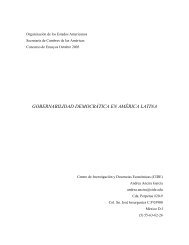The Road to Hemispheric Cooperation: Beyond the Cartagena
The Road to Hemispheric Cooperation: Beyond the Cartagena
The Road to Hemispheric Cooperation: Beyond the Cartagena
Create successful ePaper yourself
Turn your PDF publications into a flip-book with our unique Google optimized e-Paper software.
COMMENTARy by DIANA vIllIERS<br />
NEgROPONTE<br />
Nonresident Senior Fellow at <strong>the</strong> Brookings Institution<br />
<strong>The</strong> author’s his<strong>to</strong>ry of hemispheric initiatives on energy<br />
and climate change leaves readers with <strong>the</strong> question of why<br />
sustained pronouncements at <strong>the</strong> summit meetings since<br />
1994 had continually failed. Examination of <strong>the</strong> causes of<br />
failure might focus on <strong>the</strong> following: <strong>the</strong> absence of hemispheric<br />
homogeneity, growing resource nationalism, and<br />
lack of sufficient hemisphere-wide financial resources. OAS<br />
will not solve <strong>the</strong> key challenges of advancing energy security<br />
and combating climate change, because it has nei<strong>the</strong>r<br />
<strong>the</strong> juridical competence nor <strong>the</strong> funds <strong>to</strong> oblige <strong>the</strong><br />
member states <strong>to</strong> carry out <strong>the</strong> repeated recommendations.<br />
Summits of <strong>the</strong> Americas are useful as a ga<strong>the</strong>ring of hemispheric<br />
leaders, during which time several bilateral meetings<br />
can take place—but <strong>the</strong>y should not raise hopes for<br />
realistically solving serious problems. We should view <strong>the</strong><br />
summits as rhe<strong>to</strong>rical opportunities for advocacy, not vehicles<br />
for advancing pragmatic action.<br />
Solutions lie within <strong>the</strong> competency of <strong>the</strong> Inter-American<br />
Development Bank (IDB), which has <strong>the</strong> means both <strong>to</strong><br />
ga<strong>the</strong>r interested parties <strong>to</strong>ge<strong>the</strong>r and <strong>to</strong> fund identifiable<br />
projects. Conscious of <strong>the</strong> importance of <strong>the</strong>se issues, <strong>the</strong><br />
IDB currently finances Energy Innovation Centers <strong>to</strong> facilitate<br />
regional projects. Among <strong>the</strong>m are <strong>the</strong> Regional Energy<br />
Efficiency Training Center in Costa Rica, <strong>the</strong> Geo<strong>the</strong>rmal<br />
Center in El Salvador, and a Biomass Center in Brazil.<br />
If hemispheric solutions cannot be achieved <strong>to</strong> confront<br />
<strong>the</strong> challenges of energy and climate change, <strong>the</strong>n pursuit<br />
of specific bilateral programs is a realistic and achievable<br />
way forward.<br />
<strong>The</strong> U.S. Department of Energy, <strong>the</strong> Natural Resources Defense<br />
Council and o<strong>the</strong>r private U.S. entities are more likely<br />
<strong>to</strong> participate in discrete, bilateral projects than in grand<br />
hemispheric ideas. Clearly defined bilateral tasks would<br />
stimulate <strong>the</strong> talent and resources of peoples <strong>to</strong> use <strong>the</strong>ir<br />
scientific knowledge and investments effectively <strong>to</strong> advance<br />
energy and environmental projects.<br />
<strong>The</strong> author’s recommendation <strong>to</strong> pursue carbon offset<br />
agreements at <strong>the</strong> state level may provoke a constitutional<br />
challenge on <strong>the</strong> grounds that only <strong>the</strong> federal government<br />
has <strong>the</strong> authority <strong>to</strong> negotiate international agreements.<br />
However, <strong>the</strong> author is proposing joint carbon markets, not<br />
binding treaties. <strong>The</strong> proposal is more akin <strong>to</strong> commercial<br />
and transportation agreements between states than international<br />
laws. California leads <strong>the</strong> way with its proposed<br />
linkage of a cap-and-trade program with <strong>the</strong> Province of<br />
Quebec. If this goes forward, <strong>the</strong>n we can expect numerous<br />
o<strong>the</strong>r joint carbon markets. <strong>The</strong>se state-<strong>to</strong>-state agreements<br />
have <strong>the</strong> advantage of recognizing and assuming<br />
global responsibilities, but enacting <strong>the</strong>m at <strong>the</strong> local level.<br />
This may lay <strong>the</strong> groundwork for resolving o<strong>the</strong>r strategic<br />
global problems.<br />
<strong>The</strong> <strong>Road</strong> <strong>to</strong> <strong>Hemispheric</strong> <strong>Cooperation</strong>: <strong>Beyond</strong> <strong>the</strong> <strong>Cartagena</strong> Summit of <strong>the</strong> Americas<br />
<strong>The</strong> Brookings Institution ❘ Latin America Initiative<br />
58








